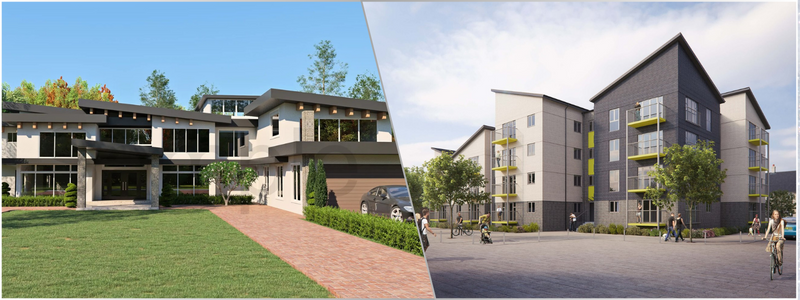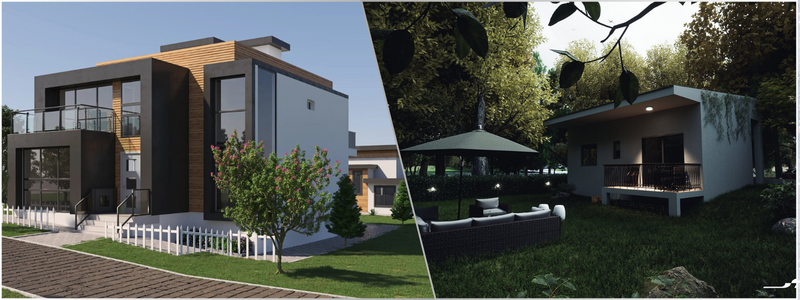Something about architectural visualization services makes them a must-have partner for any company, large or small alike. However, the whole architectural visualization process is completed after some time. Creating a flawless and faultless architectural render can take several weeks and sometimes even months. It takes utmost precision, dedication, and attention to get all the details right, down to the smallest ones.
Two factors that can easily make or break any architectural visualization design are the mood and atmosphere you use for your design. Although your renders don’t necessarily focus on environmental conditions, they significantly impact your final designs. Below is a comprehensive guide to mood and atmosphere for architectural visualization services that you can use and apply to your future projects:
 Table of contents
Table of contents
- Importance of weather on mood and atmosphere for architectural visualization
- Different types of weather for architectural renders
- Different seasons for architectural visualization projects
- Different times of the day for architectural renders
- How Cad Crowd can help
RELATED: What is architectural visualization and why architectural rendering services use it
Importance of weather on mood and atmosphere for architectural visualization
Your architectural visualization project has one important goal: to wow your clients and allow them to imagine themselves working and living in the environment you’ve made. It means that your job here is to evoke an emotional response that will make them love every part and aspect of your design. You first need a 3D architectural rendering firm to create an immaculate architectural render of the structure or building to achieve that. But of course, more than just the building alone is required. You also have to come up with a context; the best way to do this is to render unique and specific weather conditions.
Just like how weather affects your emotions, the same rule applies to 3D renders. Do you notice how you’d rather stay cozy on your bed during rainy or cloudy days while warm, bright days make you sit out in your garden to enjoy the sunlight? That’s how powerful weather conditions are on human mood. You can harness these natural and innate responses to various weather conditions to effectively manipulate your clients’ emotions and lure them into forming a connection with your architectural designs.
RELATED: 5 Myths about working with an architectural visualization service
Different types of weather for architectural renders
You can use numerous types of weather in your architectural renders depending on how you’d want your clients to feel when they see your designs. However, the general rule here is to never render extreme conditions as much as possible, except if your objective is to focus on the building’s resilience. The following are the most common types of weather you can use on your future architectural renders:
Overcast weather
Overcast weather allows the 3D visualization designer to add more warmth and depth to your architectural visualization projects. You can use cloudy days to emphasize the exterior lighting and achieve more contrast with the environment. One principle to remember here is to create early evening or late afternoon renders of overcast weather to help you create a more dramatic appeal. You can also combine sunny weather and cloudy to showcase the designs in several environments.
RELATED: Where and when to find freelance architecture visualization services and designers
Rainy day
Rainy days are inspiring and soothing. This weather condition sets a serene scene that can make the structure look warmer and more welcoming. Rendering rainy days can help you set a more intimate ambiance that will make your clients love it. This is especially great if you want to create minimalistic designs that lack intricate details or pops of color. The falling rain can also make your architectural visualizations more attractive and also more exciting as a result. Rainy days can also be more striking for interior architectural visualization services because they set a more romantic and melancholic mood.
Stormy weather
Stormy weather is the best way to go if you want your renders to be more dramatic and eye-catching. This is ideal weather for odd-shaped buildings and unique artistic designs. Stormy weather also works like magic for civil engineering projects such as airports because they adds a sense of power to their overall appeal. But you should refrain from using stormy weather for architectural renders of residential buildings and homes that some clients may find overwhelming. Instead, you can use your architectural rendering tools to create more persuasive designs using stormy weather for magazines, online portfolios, social media posts, and rendering contests.
RELATED: Mistakes to avoid when deciding an architectural visualization firm

Sunny day
You can never go wrong with using bright and plain sunny days for your rendering. This is considered the universal go-to for almost all 3D rendering designers. This kind of weather doesn’t create any distractions and is just joyful, pleasant, and relaxing in all its glory. Sunny days also let you focus on your building’s distinct features and aspects. Since all the materials, textures, and colors are visible, it can make your clients feel more confident in your designs. A bright sunny day is also ideal for emphasizing exterior design details and showcasing your render in the best light possible.
Northern lights
There’s something magical about adding the Northern Lights to the designs of your architectural renders. These exquisite lights can add pops of color and create a fantastic contrast to otherwise monochromatic designs, making the entire render seem and feel more surreal.
You must be extra careful before adding the Northern Lights to your architectural visualization projects. It would be entirely uncalled for adding these lights to visualizations for projects located in California, for example. This magical phenomenon should only be used for designs constructed in areas where you can see the Northern Lights.
RELATED: How has architectural visualization changed the way companies present projects
Different seasons for architectural visualization projects
Just like how different types of weather can affect your architectural renders, seasons do the same. Here are some tips on how to use the different seasons to create more compelling architectural visualization projects with the best virtual staging for architecture services:
Fall
Fall is the season that allows you to come up with striking and captivating designs filled with vibrant and bright colors that bring your renders to life. This is also the perfect season to use if you’re creating architectural visualizations for projects surrounded by nature, like residential homes in the countryside.
RELATED: 8 Tips for outsourcing architectural visualization for rush projects at companies
Spring and summer
Renders that use summer and spring seasons have very minimal visual differences. It means you can easily choose any of these two for your designs. These are the standard choice of seasons for renders, mainly sunny weather in general. They can help you create a clean and natural render that emphasizes all significant elements of your design. To be extra playful with contrasts and colors, you must set the scene at specific times of the day. Renders that use an early morning setting are more cheerful and energizing, while those in late evening evoke a homier feel.
Winter
While it might not seem like initially, your designs can become more inviting if you create your renders in winter. The 3D visualizer firm can achieve a stunning contrast between the warm interior and the cold exterior, adding more romance to the scene with the help of light and adding some holiday decorations to make your architectural visualization more familial and festive.
RELATED: Types of 3D visualization for architectural design and CGI projects
Different times of the day for architectural renders
The specific time of the day substantially impacts the mood of rendered images. One of the first steps is to choose the time of day you will represent in your render. Artists use the following options to tune their projects to the right mood:
Late morning or midday
Late morning and midday lighting let you showcase the true colors of different aspects of your design. Midday is considered the most popular and universal option, and designers frequently use it even to this day. The best thing about midday is that it creates enough light for 3D landscape rendering designs. It is an excellent way for your service to showcase the structure in the best possible light.

RELATED: What are architectural 3D visualization costs, service fees & rates for companies?
Night
Night settings can play an essential role in architectural rendering. Most of the time, nighttime renders can let your clients see your view on artificial illumination. Night renders allow you to draw viewers’ attention to the illuminated objects and divide the structure into various sections. This time of the day also evokes a clear difference between white or colored, direct or diffused, and warm or bright lighting.
Sunset
Sunset is the perfect time to create a romantic atmosphere for your architectural renders. The cheerful and warm colors let you place unique accents on specific parts of the structure. For instance, you can highlight the glassy and metallic surfaces of the building.
RELATED: Top 6 architectural visualization and 3D rendering trends for your company to follow
How Cad Crowd can help
Mood and atmosphere are undoubtedly the secrets to successful and effective architectural renders. Using the proper methods to create the desired atmosphere, you can help evoke the right mood among your target audience.
Cad Crowd is a platform where you can find the best artists with the know-how to use mood and atmosphere that can be useful for future architectural visualization projects.
